14 Types of Lobsters
When you buy through our links, The Breslin may earn an affiliate commission. Learn more
There are various types of lobster on the market, and you do not know them very well. You are no marine biologist. Which one has the best meat? Which one is most affordable? Which one is the best for your specific needs?
In this post, I will guide you through the types of lobsters that you can purchase to fulfill your dinner table or your recreational purpose. Along with that is a buying guide that will be of great help so that you can purchase the best lobster for your need.
What Are Lobsters And Their Benefits?
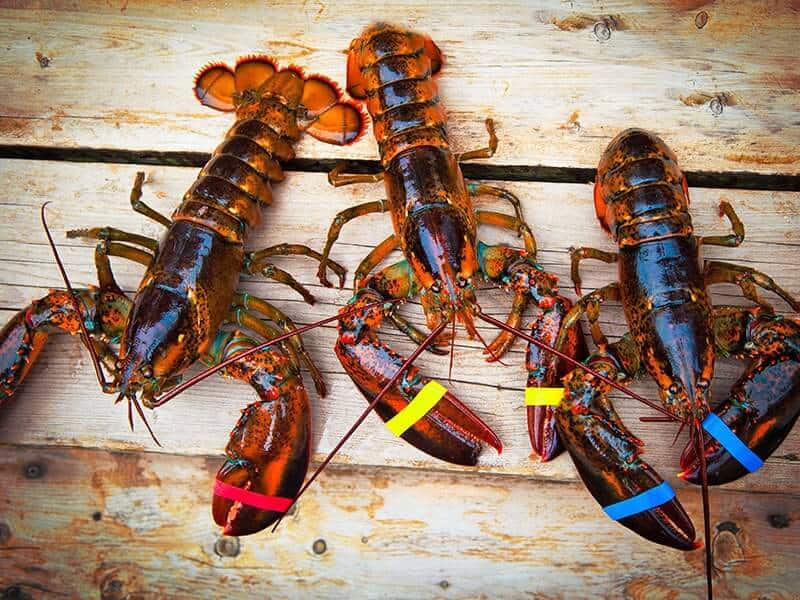
Lobsters belong to a family of species of crustaceans. They can be found in salty water areas all around the world. Geographical factors and weather conditions create a unique look and taste for each type of lobster.
Health Benefits Of Lobsters
Lobsters are also sought after for their health benefits. There are multiple studies about the benefits lobsters bring to people. The results are scientifically proven with laboratory tests and validated experiments.
Lower In Calories Than Other Types Of Meat
Lobster meat is particularly high in proteins but contains very few calories compared to other types of meat. With the same size portion, lobster meat contains a lower calorie count than the skinless chicken breast.
Moreover, protein works better than carbs and fat in creating a feeling of fullness or satiation. Also, the body burns more calories to process proteins than other nutrients. Therefore, you can count on its efficiency in weight loss.
Rich In Vitamin E, B-12, B-6
Lobster meat provides a healthy dose of vitamin B-12, a cup of lobster meat provides 51% vitamin B-12 for the daily count. It is also high in B-6.
Both vitamin B-6 and vitamin B-12 are essential for generating and sustaining healthy nerve tissues, blood cells and promoting brain function. B-12 is directly associated with many neurological diseases, while B-6 is supposed to reduce symptoms of depression.
Vitamin E has long been recognized for its role as a powerful antioxidant, not only helpful in boosting the immune system and prom cells’ resiliency against infection but also improves eyesight.
Packed With Essential Minerals
Lobster meat is packed with potassium and EPA and HDA, the latter are two types of omega-3-fatty acids, and they are scientifically proven as essential for promoting heart health.
EPA and DHA are linked to lower risks of heart diseases, including inflammation, which in turn decreases the risk of stroke. Studies also suggest its efficiency in lowering blood pressure and blood cholesterol levels.
Studies also suggest that omega fatty acids are vital to brain development and strong mental health.
In terms of nutrition facts, a cup (145 grams) of cooked lobster provides:
- 128 calories
- 27 grams of protein
- 2 grams of fat
- 0 grams of carbs
- 198% copper of the daily value
- 190% selenium of the daily value
- 53% zinc of the daily value
- 51% vitamin B-12 of the daily value
Comparison Chart Of Lobsters
Here is the comparison chart with all the information about the popular types of lobster. The chart will be a quick, useful guide that you can rely on whenever you need to choose a type of lobster to your needs.
Popular Types Of Lobsters
There are hundreds of types of lobsters worldwide, and roughly ninety percent of them can be used as food. However, not all are fished for commercial purposes.
Plus, this post is not intended to educate you on marine bio-ecology, and so I will skip the extra parts and mainly focus on popular types of lobsters that are commercially fished.
Categorized by habitat, lobsters can be classified into two major groups: cold-water lobsters and warm-water lobsters. Before getting to know these two types, I will share a common feature: softshell and hardshell, which directly affect the quality of lobsters’’ meat.
Softshell And Hardshell Season
Every lobster goes through a shedding process throughout its lifetime, commonly known as the molting cycle. As lobsters grow, their hardshell or exoskeleton doesn’t expand any further, so they need a way to grow out of it.
To facilitate the new shell to form and their body to grow, they shed their current shell, and the process will directly affect the meat’s flavors. Therefore you need to learn about lobsters’ softshell or hardshell season first in order to purchase the best quality meat.
The beginning of the softshell season is marked by shell loosening as lobsters start detaching themselves from the exoskeleton. At this time, the body is extremely delicate and fragile.
Lobsters then start to form a new shell that is larger than their own body, allowing gaps for new muscles and meat to generate. As the shell is still soft, it is also where briny water comes in.
Lobsters in their softshell season hardly qualify as quality meat since the meat is less and watery, with a fishier taste. Due to their weak body, live transportation becomes more difficult to handle and their price is generally lower.
Hardshell season starts when the new exoskeleton hardens and becomes strong; the body inside also has generated muscles, allowing lobsters to be more agile and active. They are most hungry after the shell has hardened.
Lobsters in the hard shell season are most sought after because they have more firm meat with more flavors and sweetness. Because of higher demand, you will have to pay quite much to have them on your dinner table.
It’s noticeable that lobsters generally don’t have simultaneous synchronous molting cycles. Newborn lobsters can go through this process multiple times in a year within the first several years of their life. When they enter adulthood, the frequency of shredding decreases to once a year.
Each type of lobster experiences a molting cycle at different times of the year, as they reside in diverse habitats and may be subjected to changes in environmental conditions.
Cold-Water Lobsters
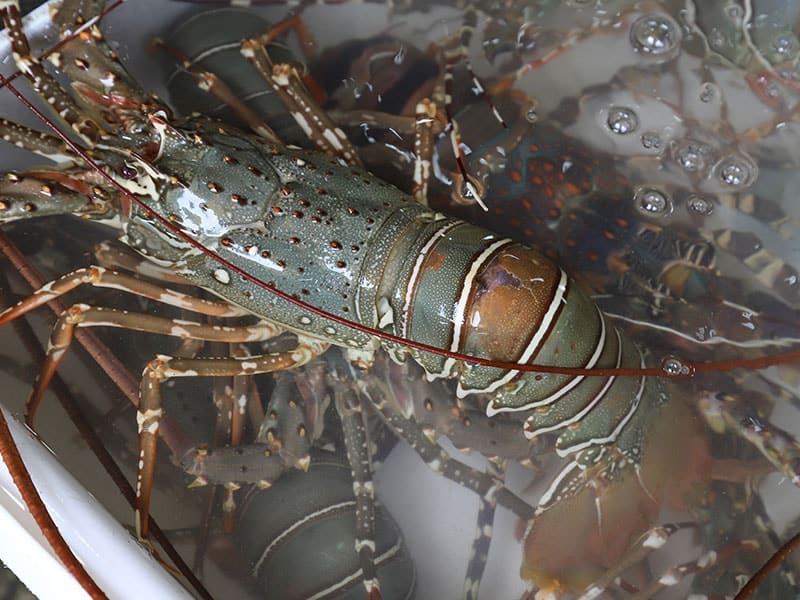
Simply put, cold-water lobsters live in colder water parts all over the world, near the two poles. They are prioritized over other sea species because it provides more meat, tender, and much richer flavors.
A distinctive feature in the appearance that helps people differentiate them is the massive pairs of claws. The claws usually make up a huge proportion of the whole body’s weight. As people are more exposed to the image of lobsters with claws, cold water lobsters are also referred to as true lobsters.
The colder temperature allows them to grow more slowly, therefore become bigger, and their meat becomes tender. Also, they have a juicy, sweet, briny taste and firm, fibrous texture that singles them out from the rest and deserve the title to become a delicacy.
Canadian Lobsters
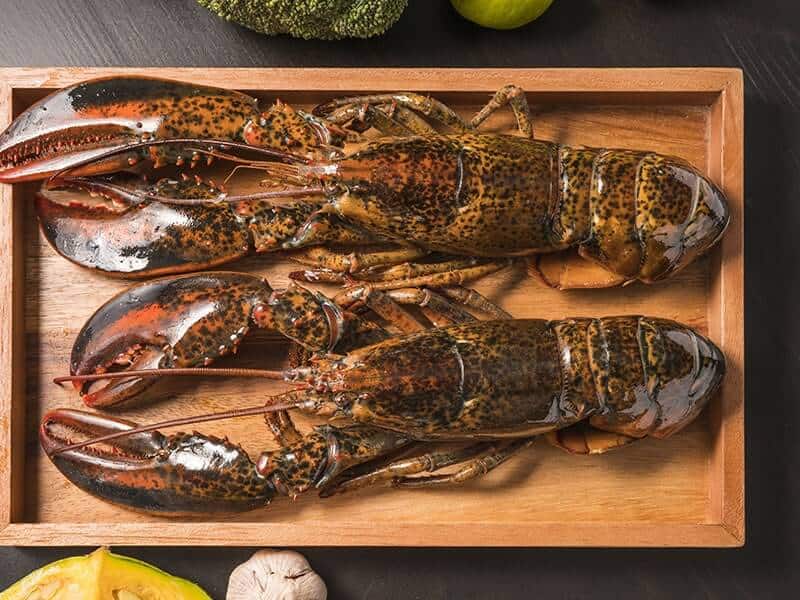
Canadian lobsters are found on the Canadian coast, near Nova Scotia or the Gulf of Saint Lawrence.
They typically reside at a depth of 13 to 164 feet and hide from predators around coral reefs and rocks under the sea. Thriving in a cold temperature between 2 to 20 C of the northern area, they develop a hard and stiff shell, with a bigger body than other lobsters.
These crustaceans have a huge body with two claws; one is a little bigger than the other and a hard shell of mottled green and brownish color.
Canadian lobster had an amazing taste of sweet and brininess and surprisingly dense meat. The typical size ranges from 5 to 6 ounces, and they survive 72 hours after removing from water, so delivery and transportation are easy, allowing them to reach you alive and fresh.
These lobsters are harvested in the winter months from October to January and during the hot summer of June to July when the market supply is abundant, and you need to actively keep an eye out for them; therefore, the price is not pleasant.
The average price for frozen lobster, including shipping is $65 per pound of lobster tails, while the average price for live lobsters is $20 per pound.
Maine Lobsters
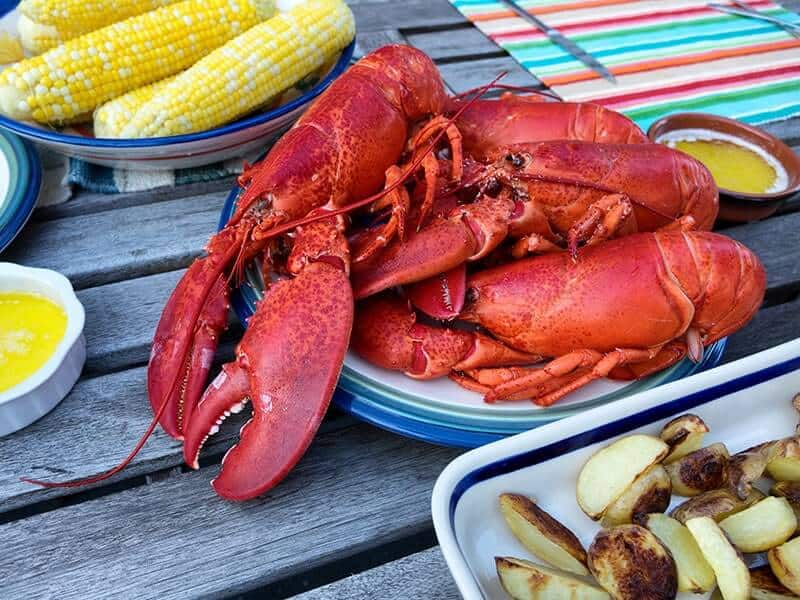
Prized as the world-renowned type of lobster that has the best flavors of all, Maine lobsters are the most-hunted seafood on the marketplace. They are found on the Atlantic coast of North America, around the Maine area so they are commonly called Maine lobsters.
Belonging to the same species as their Candian counterparts living in the nearby water, they have a similar appearance, with a huge body and two massive claws.
As Maine has a warmer temperature than nearer-polar region Canadian water, it creates a perfect habitat for Maine lobsters to develop a softer body and a smaller size than their Canadian counterparts.
Although less competitive in size, their meat is more tender, with an unbeatable sweet, rich brininess that can satisfy the most sophisticated taste buds. The fresh and delicious-tasting flavors made them the most-seeking lobster, in high demand all year round.
When Maine lobsters are removed from the water, they can survive up to 48 hours. The transportation of the Maine lobster is carried out overnight to maintain quality, flavor, and freshness.
You can easily purchase this top-of-the-world delicacy on online seafood markets, and they offer both live and frozen lobsters freshly delivered to your door.
The best season to look out for hardshell Main lobsters is from May to June, when the lobsters move near-shore and in the fall months, from October and November. Soft-shell lobsters are more abundant in late summer from June to October.
If you travel To Maine, you will have a wonderful opportunity to enjoy cheaper and fresh-tasting directly off the port where fishers come back after their daily catch or in restaurants along the coast of Maine.
For folks living in local areas of Main, the price of lobsters is generally cheaper compared to other parts of the country; it is such a fortune for those folks living in local areas.
The price has never exceeded 20$, says a local resident. And she recommends you walk around and explore as the price can be strikingly different between uptown and downtown.
Outside this region, the price can be a bit tough for your budget because it involves shipping and storage that require laborious attention and effort.
The average price of frozen shipped items is around $70 per pound. And you should look out for special exclusive discounts, a lot of online markets offer them to attract more people.
New Zealand Lobsters
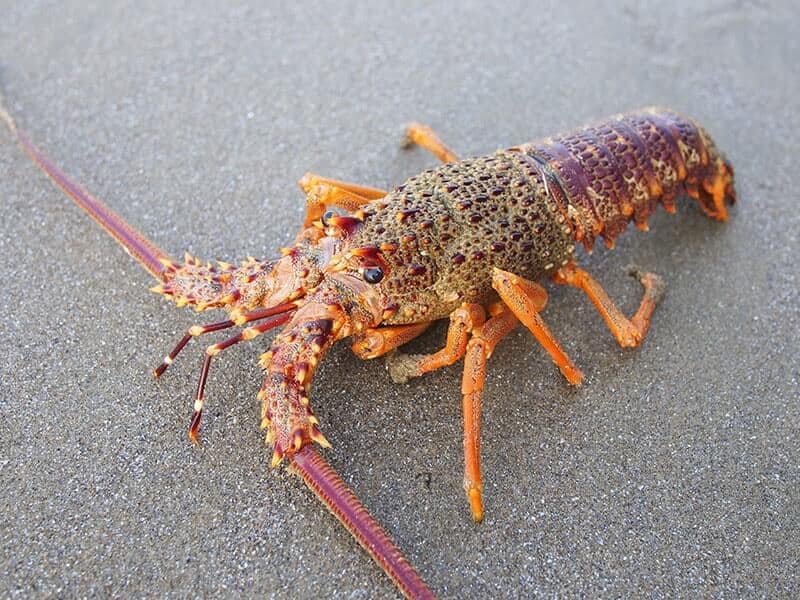
Here comes another delicious-tasting lobster, harvested from the sparkling pristine, subtropical water far way down to Southern Pacific water regions.
New Zealand has 2 species of rock lobsters (spiny lobsters), the most common of which is the red rock lobster. Red rock lobster has a beautiful color, ranging from deep red to a vibrant fiery orange.
Lobsters are strictly marine species, but they are sometimes confused with New Zealand crayfish because of their resemblance in appearance to rock lobsters but have two large crushing pincers similar to cold-water lobsters.
To be correct, New Zealand Crayfish live in freshwater areas, including lakes, rivers, ponds, and streams. Locals do not distinguish them from marine lobsters; both are called “koura”.
New Zealand lobsters earn themselves a place in the list of top lobsters in the world; it has a luxurious taste: slightly sweet, delicate, juicy, and a meaty, succulent texture that offers a fulfilling mouthfeel.
The best season is from May and lasts until February of the next year, so it is time for you to never find it difficult to purchase this delicacy as they are year-round available in the market.
In terms of price, the lobsters do not come at a low price but still affordable to some extent. The average price of frozen, shipped lobsters is $50/lb for a whole lobster and $25 per pound for tail meat.
On average, it costs $60 for a pound of live New Zealand lobster; it is because transportation adds a pretty significant markup to the original price.
Slipper Lobster
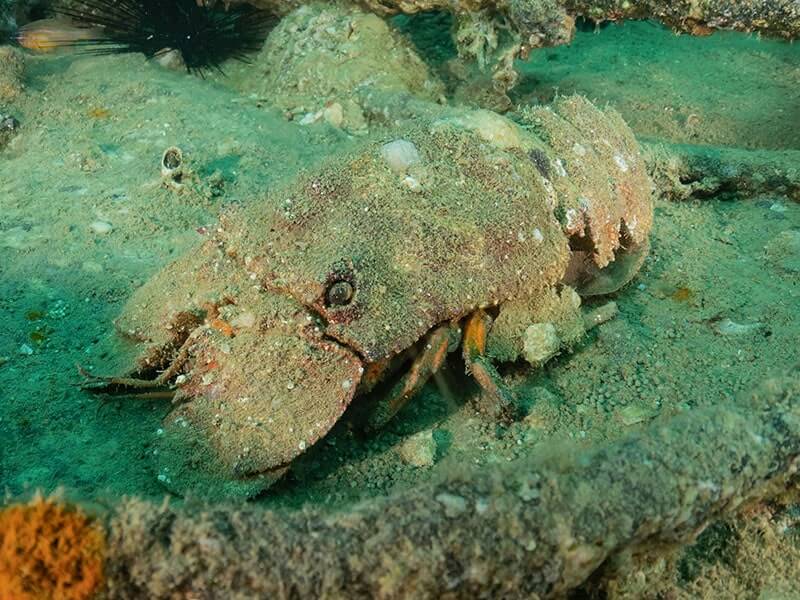
Slipper lobster is also a type of edible lobster. It is the best option for a proper taste test of lobster meat without the need to splurge on too much money. With these, you can have a budget eat but a so-called luxurious lobster meal.
They are inhabitants of warm water all around the world, but the majority is harvested from warm water regions in Asia, particularly China, Vietnam, Thailand, and tropical Australia. They live in underwater regions in a depth range from 8 to 70 meters.
As a lesser-known type of lobster, the meat is edible but not really a popular choice for seafood lovers and hardly rivals the other superior lobsters. It has white, firm meat and a sweet taste and meat texture somewhat similar to shrimp.
Slipper lobsters in the Mediterranean and Atlantic region are considered endangered due to overexploitation, so they do not hold much interest for the fisherman in the US.
Thus, you can still find them provided in the seafood market as lobster tails, and most slipper lobsters in the US market are exported from China.
They are usually featured in seafood soups or salads, or with any other dishes that call for lobster meat. Slipper lobsters can be grilled, steamed, or baked; all are equally delicious.
Although it is not quite the kind of dish that is the centerpiece of a typical gourmet meal, you shouldn’t hesitate to try it in any recipe that calls for lobster meat because it still qualifies as a great ingredient for a delicious seafood dish.
What’s more, the price of these lobsters is completely affordable, offering you a great opportunity to celebrate something special with your friends or family.
Squat Lobsters
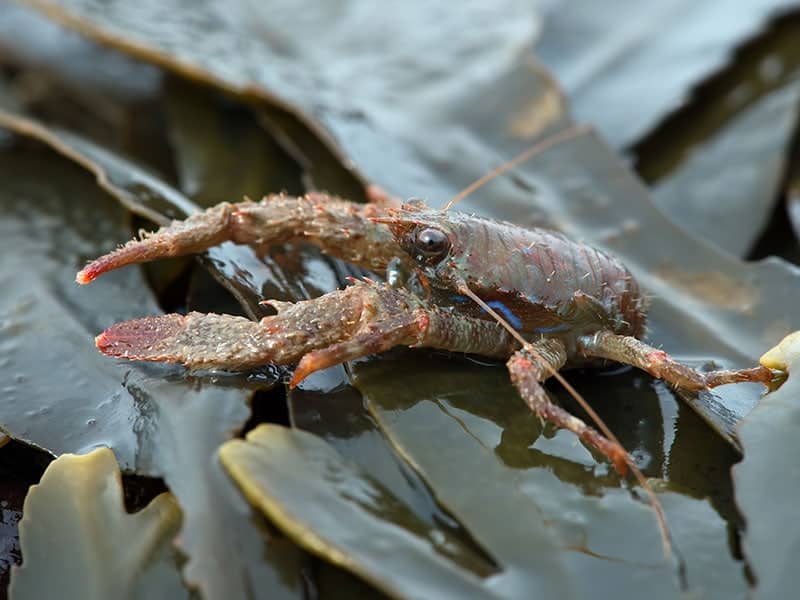
Squat lobster is another type of unpopular lobster. They resemble the look of a crab more than a lobster, with a shorter spine, small flat body, and less prominent front claws.
Squat lobsters’ meat is often commercially sold in restaurants and displayed as lobster or incorporated in seafood dishes.
Besides being used as food, squat lobster meat is also purchased to produce cheap feed in fish farms and prawn farms. This is partly because their meat contains astaxanthin, a pigment that acts as a coloring agent for the meat of farmed salmon and trout.
Despite their worldwide distribution and great abundance, there are few functioning fisheries for squat lobsters. Exploitation activities currently occur only in Latin American areas, mainly in Chile.
Warm-Water Lobsters
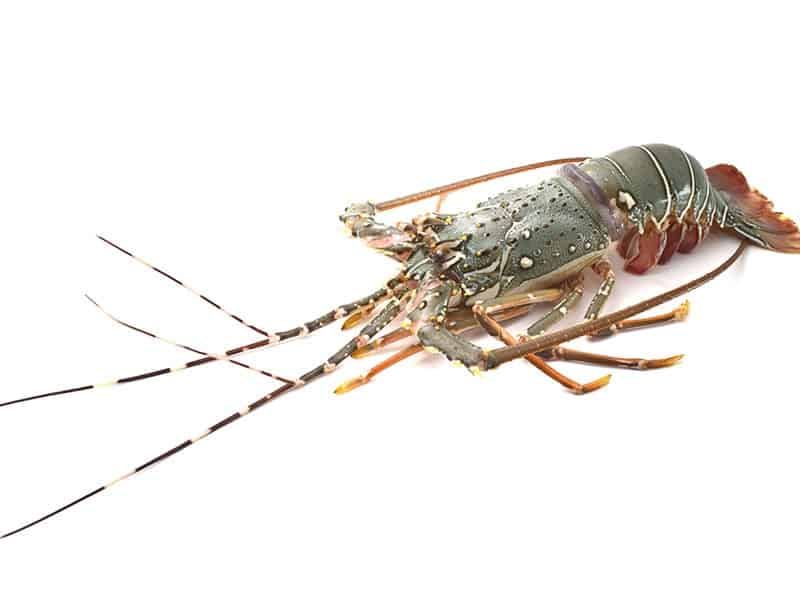
Living in warmer water parts around the globe, the lobsters acquire a totally different appearance than their cold-water counterparts. They are commonly known as rock lobsters or spiny lobsters.
Warm-water lobsters are considered “false” lobsters as they have no front claws. The spine is shorter than true lobsters, with two thick antennae on the head and 5 sets of spiky front claws. The shell is also rougher, with more spikes on the two sides of the body.
In general, the look is more similar to a giant prawn than a lobster. The body also is slightly smaller than cold-water lobsters. The average size can range from 1 to 5 pounds, but some outstanding individuals can grow up to 15 pounds.
They are seen as cheaper alternatives to cold-water lobsters and lack quality and flavorful, savory taste. In terms of texture and taste, warm-water lobsters’ meat has a fishier flavor, with a bland taste and mushy texture.
Warm-water lobsters are mostly sought after for the tail meat, as it is the only part that can be used for culinary purposes. Therefore, you will find it less common to be provided as live lobsters; frozen tails are more abundant on the market.
Caribbean Lobsters
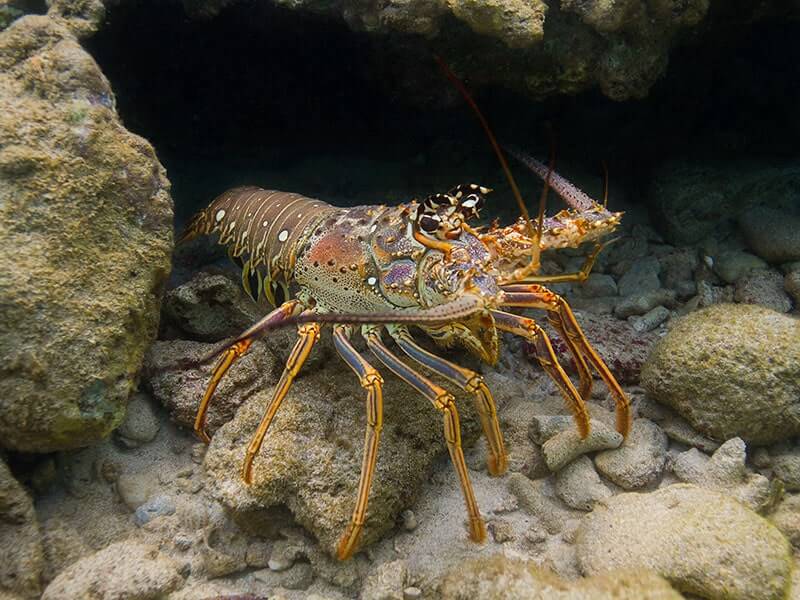
Caribbean lobsters are produced off the North American coast, throughout the Gulf of Mexico, and on the shore of the Caribbean.
They reside in tropical water all around the world, hiding between rock, burrows, dens, and coral reefs during the day, and practice nocturnal habits as they look for food at night.
Caribbean lobsters are known as the largest crustaceans living among coral reefs, with the body length ranging from 25-40 centimeters and a reddish-brown shell, and weigh up to 15 pounds.
Living in a warmer region, these lobsters provide eaters with juicy, tender tail meat and a sweet, briny flavor.
The best season to enjoy these lobsters is between August and March, as the supplies are abundant and they offer more affordability.
The price is generally much more pleasant compared to other types of lobster. On average, the price of frozen lobster inclusive shipping is around $35 per pound, while it is around $25 per pound for live lobsters.
South African Lobsters
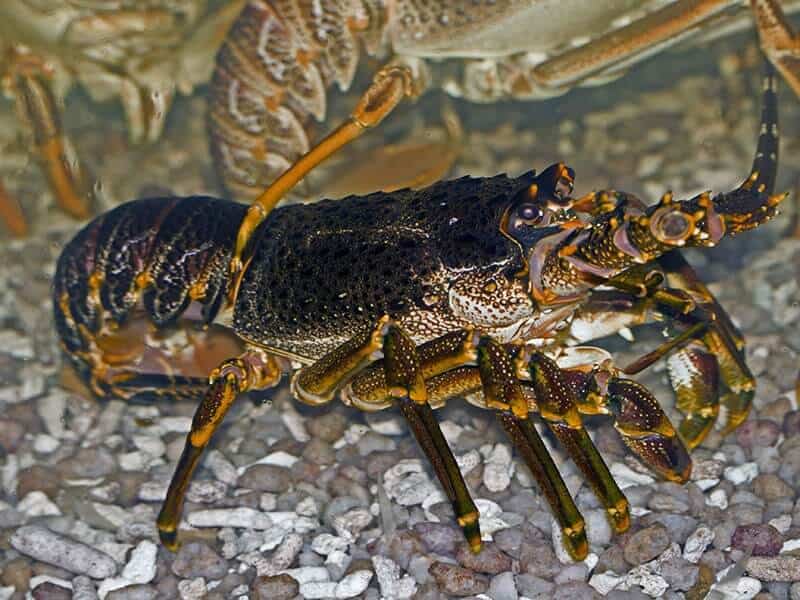
These lobsters reside in the waters of Southern South Africa at depths of 50 to 150 feet. The water here is a little colder than other warm water areas, so they grow slower and carry more similar flavors of cold-water lobster, with a firmer texture, praiseworthy sweetness, juicy meat, and pronounced flavors.
The distinctive bright red color also sets them apart from Maine specialty. Its tail counts for 45% of the total body weight, which is outstanding and gives it one of the highest tail yields of any lobster in the world.
The lobsters are always in great demand, no wonder why it is among the most expensive lobsters in the world.
They are harvested year-round, but the supply tends to increase during the winter months sharply. November marks the beginning of the season and lasts until April of the next year.
Freshly harvested and exported all the way from South Africa, you can expect the lobster offered in the US market as frozen tails or frozen uncooked lobsters.
The average price is around $45 per pound for frozen lobster tails, and the weight can range from 0.25 to 1.25 pounds, so it is a good deal.
Australian Lobsters
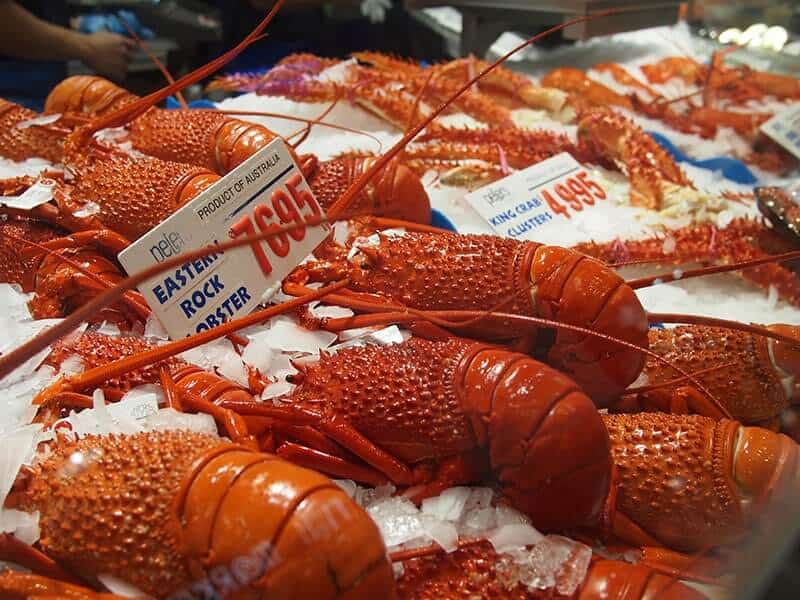
It is not extra to say this is the prized, finest warm-water lobster tail in the world.
They are harvested all the way from the waters of the Great Barrier Reef in Northern Australia.
The warmer habitat in Australia allows these tails to have firm meat. These tails offer succulent, juicy meat with a mild and salty taste.
Australian lobster tails are known for their massive size, with each tail weighing in at nearly a pound and a half. So it means more quality meat for you to enjoy.
These tails are freshly frozen and shipped overnight to your doorstep, making sure the whole flavors and fresh taste are well-preserved, allowing you to have a taste of their high-quality meat.
Australian lobsters are widely available year-round, so you don’t need to wait long to enjoy them. The average price for a pound of frozen lobster tails (including shipping) is $60 per pound.
Transportation from Australia to America can be complicated and add a markup price compared to locally harvested lobster. On average, the price for live lobster is $45 per pound.
Reef Lobsters
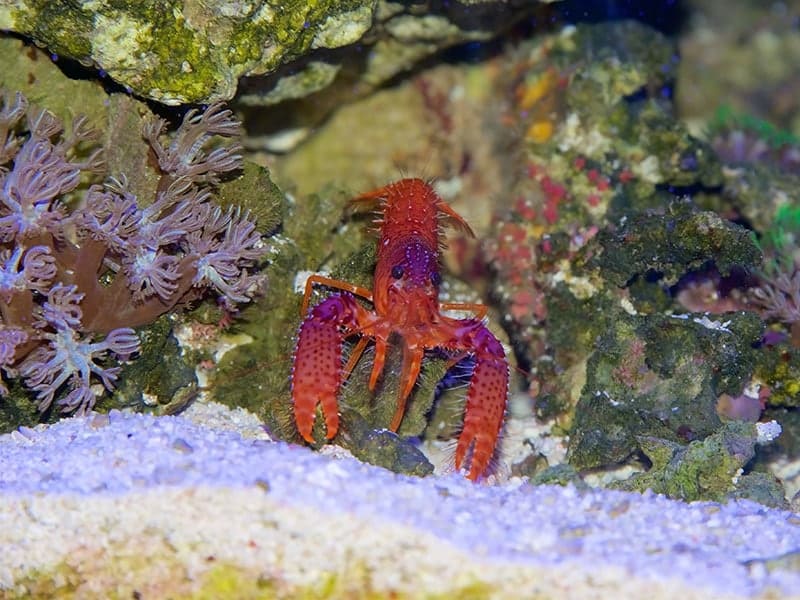
Reef lobsters belong to a small lobster species that live in coral reefs around Indo-Pacific, Caribbean, and the warm Atlantic Ocean.
Their body lengths grow up to 10–13 centimeters or 4–5 inches, depending on species. They have a mesmerizing look, contributed by a vivid bright shell, typically red, orange, purplish, and even white.
The shell is also marked with decorative spots, rings, or stripes, making the lobster the most unique, catchy-looking appearance among their genera.
Reef lobsters are not suitable as food; instead, these beautiful-looking lobsters are the star in the aquarium. Known as having timid characteristics, they tend to hide away from strangers among coral reefs and rocks during daylight and go out to look for food at night.
On average, with a budget of 20$, you can own lobsters with a medium size of 2 inches; they will certainly impress your guests and catch all their attention, maybe not as food, but as an interesting recreational newcomer in your aquarium.
California Lobster
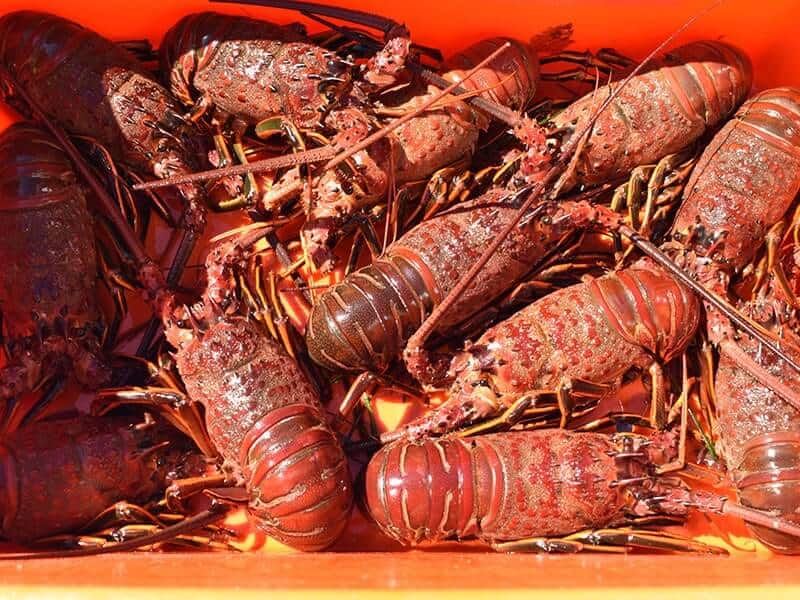
California lobsters are a species of spiny lobster found off the Eastern coast of the Pacific Ocean, from Monterey Bay, California, to the Gulf of Tehuantepec, Mexico.
They have a red-hued brown colored shell and other body parts similar to those features found in warm water lobsters. They grow up to 24 inches in body length, and typical size ranges from. It has delicate flavors and a creamy, sweet taste and white, firm meat.
The regular weight for each California lobster offered in the market is 1.1 to 1.4 pounds for the normal size and can be up to 2 pounds or more for extra-large size.
There is a permit and strict regulations to follow for these to be commercially fished. They are hand caught by hard-working scuba divers with specialized gear.
California lobsters are fished for both recreational and commercial purposes. They are commercially important products for local sea folks and have brought great economic benefits to the west coast fishery industry.
Currently, 95% of lobster yields In California are exported to China, where there is a high demand for them, and the Chinese people are willing to pay triple the price compared to local folks.
The late fall-winter months from October to March are the best time to purchase this type of lobster. The average price for live California lobsters is $25 per pound, which is a fairly good price compared to other types of lobster and the quality it offers.
Scampi Lobsters
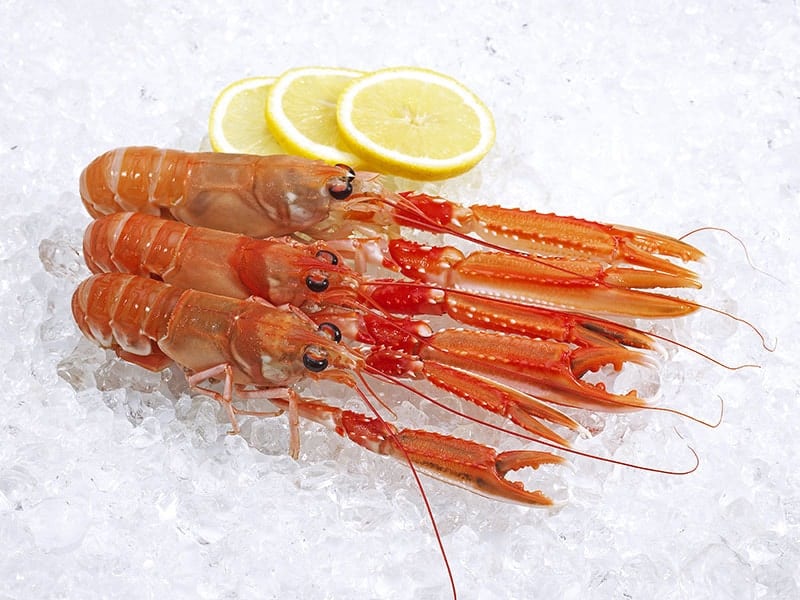
These tiny buddies are known as mini lobster, they have many different names including Dublin Bay Prawn and Norway Lobster. They can never beat regular lobsters in terms of size, but they have their unique charms in terms of texture and flavors.
You can make a budget lobster meal with scampi that allows you to taste the luxury without having to spend a big amount of money. They are ideal when you are in the mood for a change of taste and novelty.
The looks resemble a lobster, but much smaller and slimmer, with a fatter body. Body length is up to 18 centimeters, therefore far from being qualified as a typical lobster. They are also considered the same as prawn in some areas because it has a light orange colored shell.
While this lobster is not commonly seen and sold in the US market, they are widely recognized as a commercially important product in all over Europe, leading to the fact that these lobsters are being overexploited in some areas.
Scampi lobsters can be harvested all year-round. Despite its small and not-so-much tail yield, the tail meat is still high on demand for its characteristic taste and flavor. They say scampi tail meat tastes sweet and juicy when it is fresh.
Mainly harvested in British and around Ireland ocean parts, they are widely used in British and French cooking.
In French cuisine, these lobsters are referred to as langoustines, a popular dish which are poached scampi lobsters with a pinch of salt and served fresh with garlic butter.
French people love the fresh taste of scampi lobsters served with a light seasoning, such as a squeeze of lemon juice, white wine, and butter. Seasoning is vital in complementing the flavors and taking them to a higher level.
For British people, scampi is deep-fried in batter or breadcrumbs (quite similar to Japanese fried food called tempura) and usually served as fish and chips, a British traditional fast food.
British folks can purchase these mini lobsters easily as they are sold largely in supermarkets and restaurants.
These are also sold in the market (mostly in Europe) as scamp tail, which has a look of a large shelled shrimp; they can be prepared in many different ways.
There are commercial versions of scampi lobster widely sold in the marketplace, which are made from various seafood shaped into scampi tails.
Popular Lobster Recipes
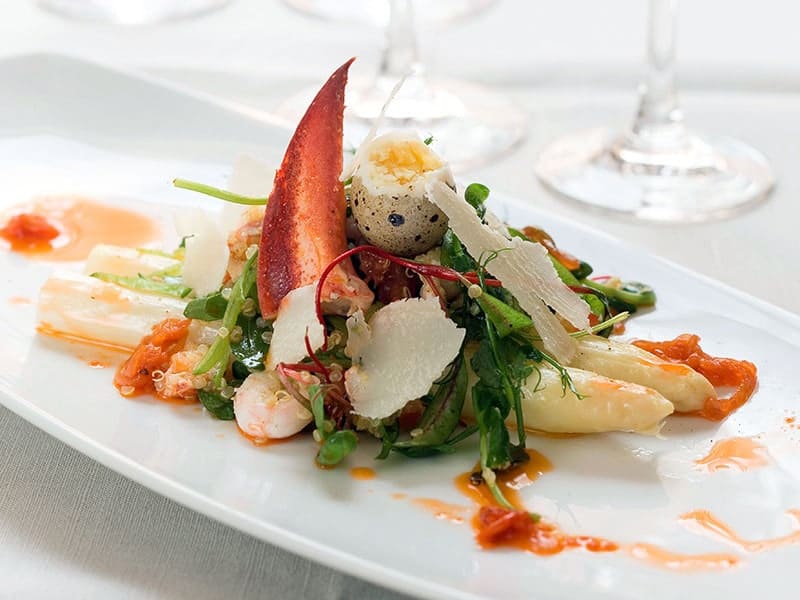
The delicate and superior flavors together with tender, juicy and meaty texture contribute to making lobster the king of seafood. Lobsters can be made into various wonderful dishes in terms of both look and taste.
Lobsters are best enjoyed as a simple steamed, boiled, or grilled, baked dish. There is literally no need to put them through any complicated process or cook it with many ingredients. What people love are its delicate texture and original, fresh, briny flavors.
Also, in enjoying the meat in its most original flavors, lobsters are mostly served as the main dish with some side-dish like roasted or blanched asparagus, bread, butter sauce, etc.
The side dish cannot be too strong in flavors; they just act as an enhancer to the flavors and complete the fancy look of a gourmet meal.
Besides enjoying the fresh, original taste, people also love to incorporate savory and sweetmeat into various seafood dishes, including lobster salad, lobster roll, macaroni, and cheese, etc.
The wonderful combination of lobster meat and various flavors and textures are all worthy of being included in your cookbook. Below is a list of must-try recipes if you have lobster on hand.
- Broiled lobster
- Baked stuffed lobster
- Grilled lobster with garlic-parsley butter
- Lobster macaroni salad
- Lobster risotto
- Lobster salad
- Grilled lobster with vanilla cream sauce
- Lobster tacos
- Lobster bisque
- Lobster macaroni and cheese
- Lobster and avocado salad
- Lobster cocktail
How To Buy Quality Lobster Tails?
There are some factors that you should closely supervise in order to choose the best tasting lobsters for your meal and, more importantly, make the most bang for your buck.
Hardshell Season
Generally, lobsters in their hard-shell season taste more delicious than soft-shell lobsters. The meat has a firmer, more delicate texture and a sweeter taste. However, it may depend on the type of lobster.
For Maine lobster, it may be the opposite. Local people recommend soft-shell Maine lobster because the meat is tender and has richer brininess.
Choose The Healthy Ones
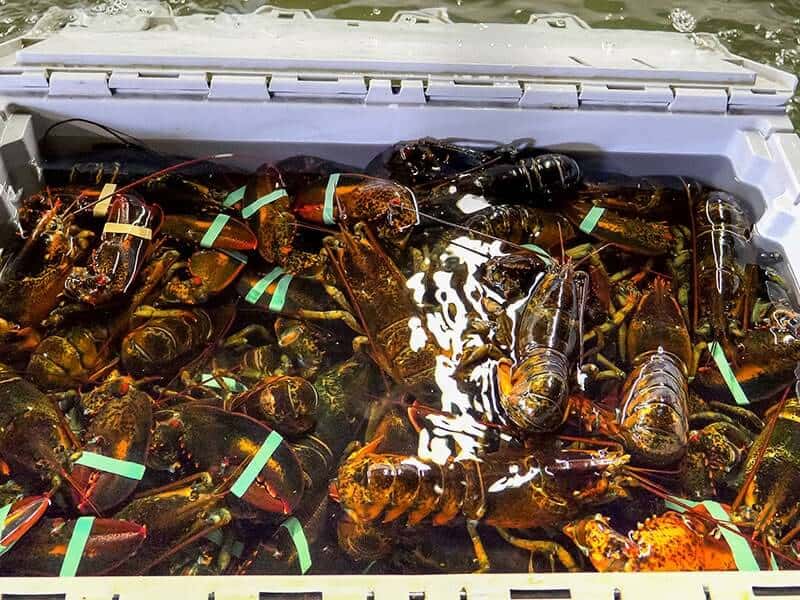
People always care to choose the healthiest. You pay attention to the appearance to indicate the healthy ones. Freshly caught live lobsters are quite agile and move around quickly.
For lobster tails, you can pay attention to the following things. The shell should be firm and strong. There are no cracks or crevices on the shell, and the colors are right to their regular look.
You should also notice any unusual signs in the meat. Clean lobster meat is white, firm, juicy, and has a distinct aroma of the ocean. Spoiled lobster meat has unpleasant odors and a mushy texture, sometimes with dark spots visible on the meat.
Net Weight
While people tend to only care about the above factors, few really know how to choose quality lobster for their budget. A good deal has to be worthy of all the money you spent.
Obviously, nobody wants to spend an extravagant few hundred bucks just to find out what they get is mostly shell and just a little meat. Therefore, closely refer to the meat yield of each type to make sure you get the bang for your buck!
FAQs
So far, you have learned a lot of things about types of lobsters. You are not sure that’s what you are looking for? Below is the list of most discussed questions about lobsters. Hopefully, you will have all you need after reading this!
It’s The Season Of Lobsters, Don’t Miss Out!
Summer is around the corner; it is the most welcomed time of the year for seafood lovers, because this is the season of many types of delicious lobster, including the world-renowned Maine and Canadian lobsters.
And you’d better keep an eye out; you may be lucky to catch a real bargain with low-price yet high-quality lobsters.
A lot of online seafood markets are now offering coupons and discounts, and lobsters are perfectly stored, packaged and shipped immediately to your door.
I hope you have learned something useful from this post, perhaps you can impress someone with this interesting information, or certainly be able to call yourself a lobster connoisseur after reading this.
If you have any opinions and contributions, or any wonders that need to be answered, please leave a comment. And don’t forget to share this with your friends and family, they’re gonna need it!

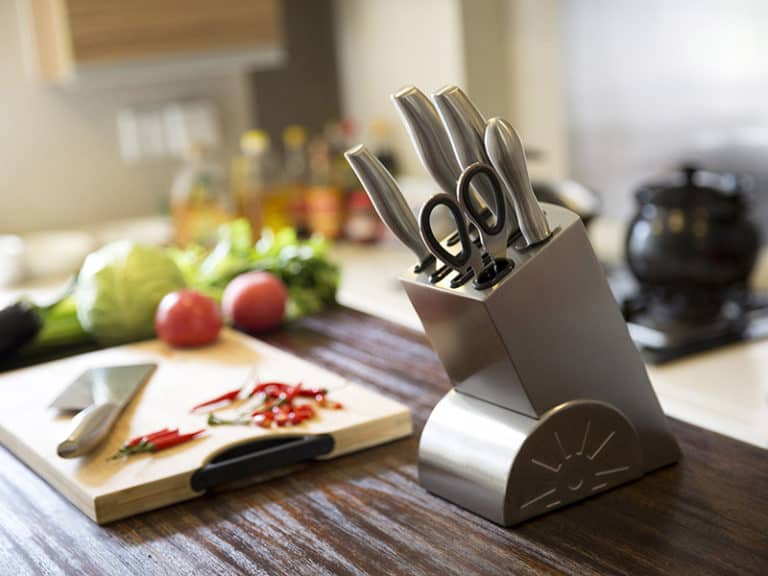
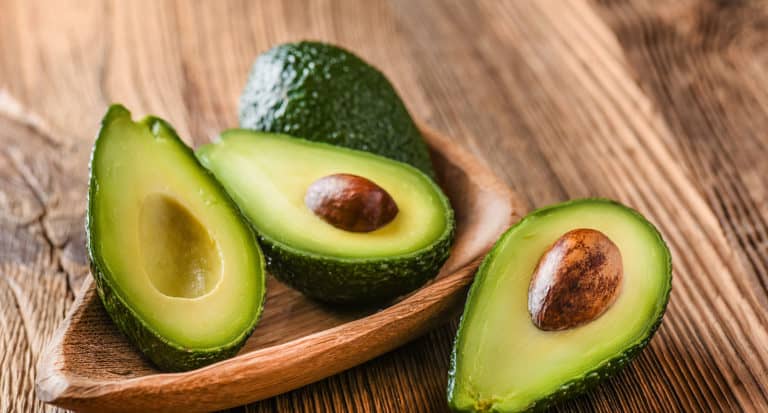

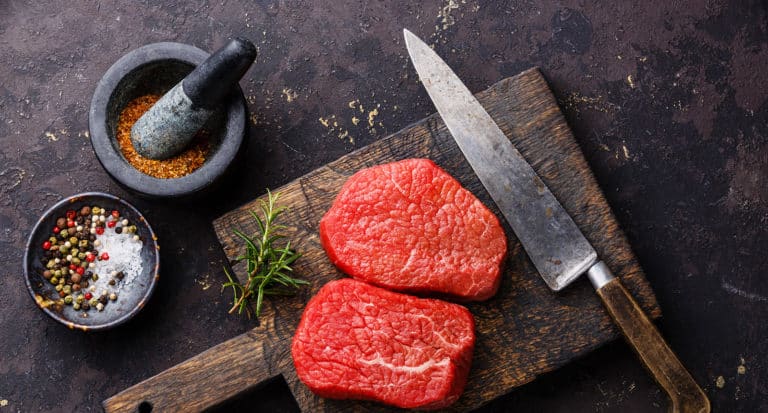


Amanda Collins
Founder and Senior Culinary Editor
Expertise
Culinary Arts and Management, Food Journalism and Critique, Recipe Development and Testing, Global Culinary Traditions, Sustainable Food Practices
Education
Institute of Culinary Education (ICE), New York, NY
Program: Diploma in Culinary Arts
Focus: Intensive hands-on training in culinary techniques, recipe development, and kitchen management, preparing students for professional roles in the culinary industry.
Monroe College, New Rochelle, NY
Program: Associate in Applied Science in Culinary Arts
Focus: Practical culinary skills, including cooking techniques, menu planning, and kitchen operations, with an emphasis on hands-on experience and industry standards.
Amanda Collins is a seasoned chef and food editor with a deep love for global flavors. Trained at the Institute of Culinary Education and Monroe College, and with over 15 years in the culinary field, Amanda has refined her skills in kitchens worldwide. Her background in food studies gives her a unique ability to share both recipes and the cultural stories that shape them.
As senior culinary editor at thebreslin.com, Amanda’s work brings authentic dishes to life, inviting readers to explore new flavors and techniques from around the globe. Her approachable style makes it easy for anyone to bring a bit of the world’s cuisine into their kitchen.